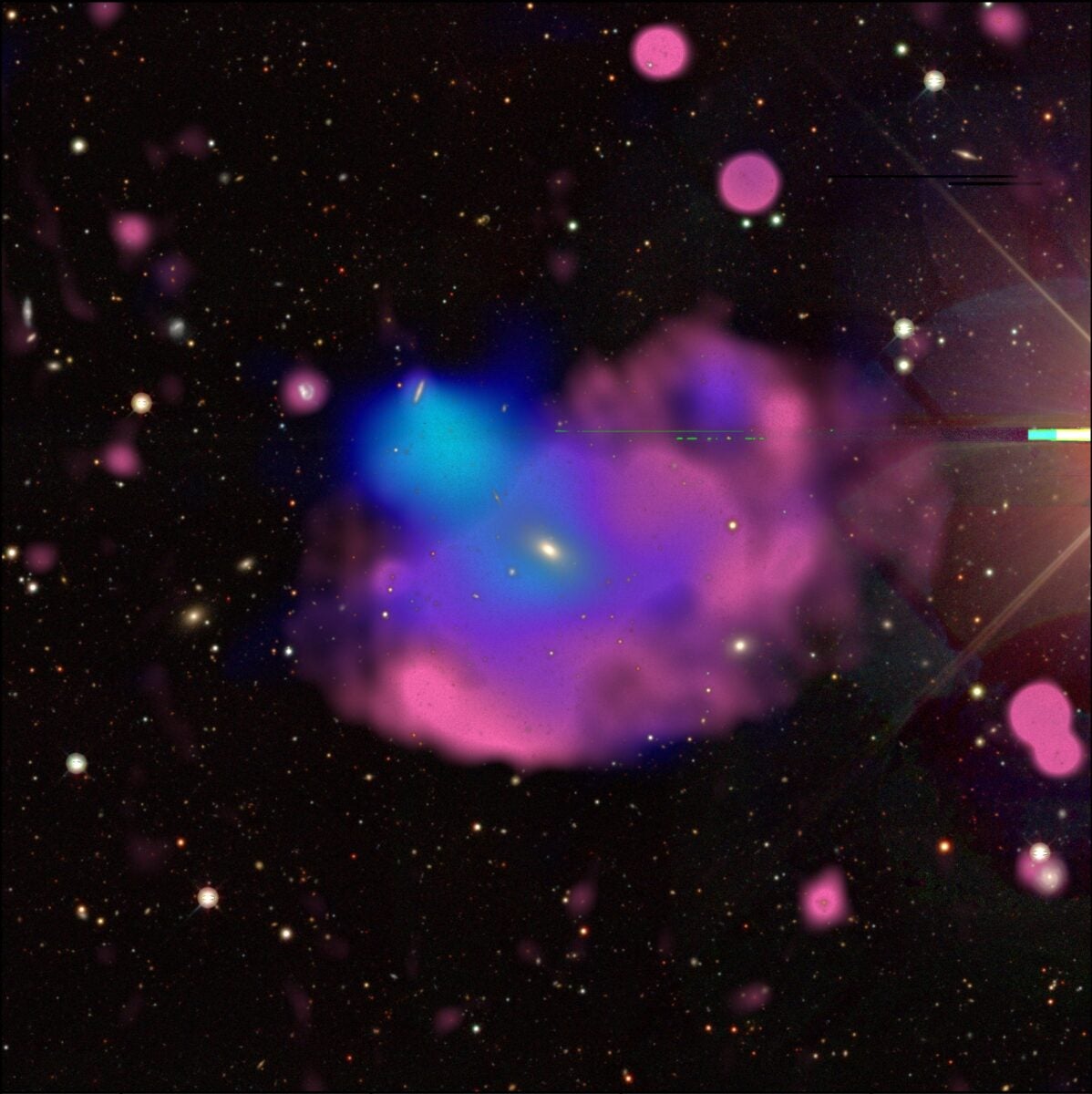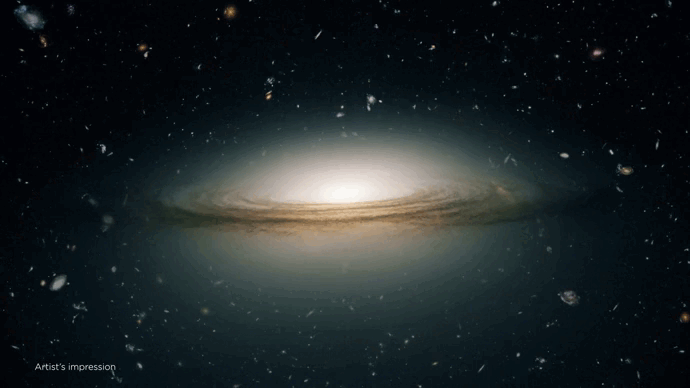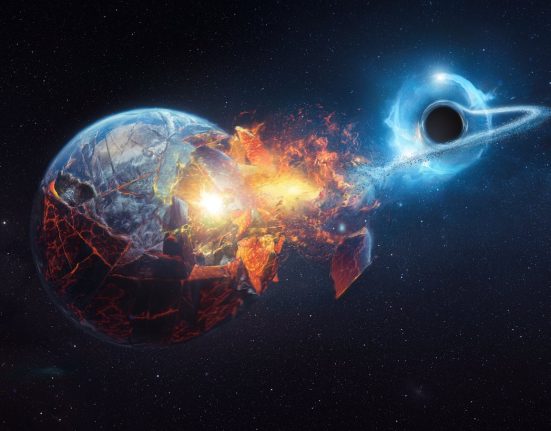
A mosaic of Cloverleaf's radio emission at multiple wavelengths: visible light observations from the Legacy Survey DESI (Dark Energy Spectroscopic Instrument) in white and yellow; XMM-Newton X-rays in blue; and ASKAP (the Australian Square Kilometer Array Pathfinder) radius in red. Credit: Xiaoyuan Zhang and Matthias Kluge (MPE), Baerbel Korbalski (CSIRO).
In 2020, when astronomers used the Australian Square Kilometer Array Pathfinder (ASKAP) they discovered ghostly circles of radio emissions in the sky that were so gigantic that they exceeded ten times the size of our Milky Way. And so far, no known cosmic phenomenon could explain how they came to exist and what they are.
The highly inflated profiles of the giant circles did not match circular features common in radio images, such as the shell of material shed by a dying star or a frontal view of a dusty protoplanetary disk; They don't look like anything mentioned. in previous studies. And because a handful of strange objects could be seen by more than one telescope at different times and wavelengths, astronomers ruled out the possibility that they were banal artifacts present in the raw telescopic data. Due to the mysterious origin of the huge space rings and their brevity, the discovery team named them “Odd radius circles”u ORC.
Four stranger radio circles recently appeared in more recent ASKAP data and in images collected by South Africa's MeerKAT radio telescope, including an intriguing ORC with a doublelobed feature. With such a limited ORC data set, it is difficult to dig into its origins for astrophysicists struggling to understand the physical processes that could produce such massive emission rings. “I would say we are really at the beginning of understanding these types of systems,” says Xiaoyuan Zhang of the Max Planck Institute for Extraterrestrial Physics (MPE) in Germany.
A lucky four leaf clover

In a new study, Zhang and his colleagues propose the origin of one such radio circle called Cloverleaf, which is located about 600 million light years from Earth and spans more than a hundred kiloparsecs (the Milky Way is approximately 30 kpc width). Based on observations collected by the European Space Agency's XMM-Newton telescope, researchers say Cloverleaf may have been created by two groups of galaxies that gravitated toward each other and are in the midst of a disorderly merger. The galaxy group appears to contain at least a dozen galaxies as old as the universe that are at varying levels of disfigurement, although it is not yet clear how many are in each group. It is possible that the merger created shock waves that accelerated fossil cosmic ray particles within the galaxies, which would have created the observed radio emission, Zhang and his team reported in a paper published in late April in the journal Astronomy and Astrophysics Letters.
If the findings pan out, astronomers will be one step closer to discovering how ORCs are born and swell to light-year sizes. “The fact that we are one of the first groups to suggest some origin, of course, makes us very happy,” says the study's lead author, Esra Bulbul of the MPE. “We are excited about the prospect of what these observations really mean, but there are still many open questions we would like to answer.”
For example, galaxy mergers frequently occur without any associated ORCs being recorded, so it's important to pin down what creates the galaxy clusters that produce unique Cloverleaf, Bulbul says. Since there are only a handful of known ORCs, any explanation for their presence must also explain their overall rarity. “That's the question we're trying to answer,” he says.
Persistence and a pinch of luck.
Bulbul and his team analyzed data from the German-Russian Extended Roentgen Survey with an Imaging Telescope Array (eROSITA) space telescope, which collected all-sky X-ray radiation from 2019 to February 2022. observations were paused to protest the Russian invasion of Ukraine.
Based on just seven minutes of observations, the team detected “something, but it was not really a detection,” says Bulbul. To learn more, researchers collected a little more than five hours of data from XMM-Newton last year. This allowed the team to probe large swaths of the sky much deeper than eROSITA ever could.
“As soon as I received the observations, I sent them to Xiaoyuan,” Bulbul recalls. “The next morning, I asked him, 'So, did you check it out?' To my surprise, he said, 'Yes, it's a detection!'”
The XMM-Newton data basically showed that up to 700 billion solar masses of hot gas were floating among the dozen galaxies, Zhang explains. The gas reaches temperatures of around 15 million degrees Fahrenheit (8 million degrees Celsius), providing the type of environment where cosmic rays are accelerated.
“We were very lucky,” Zhang said in a nasa statement. “Turns out the eROSITA sources couldn't have been from Cloverleaf, but they were convincing enough for us to take a closer look.”
The source of the energetic cosmic rays is currently unknown. They may have been created when supermassive black holes lurking at the centers of galaxies experienced bursts of extreme activity, according to Kim Weaver, an XMM-Newton project scientist at NASA's Goddard Space Flight Center in Maryland, who does not participated in the study. Perhaps “relic electrons from that ancient activity were reaccelerated by this fusion event,” she said in the NASA statement.
What defines an ORC?
However, not everyone is convinced that Cloverleaf checks all the boxes that conventionally define an ORC. Ray Norris, an astrophysicist at Western Sydney University in Australia who led the discovery of the first ORCs using ASKAP in 2020, says Cloverleaf lacks a prominent telltale glow at the edges of the radio emission normally associated with celestial weirdos. “They have found a diffuse cloud of radio emission with some structure,” says Norris. “Interesting, but not an ORC.”
He noted that astronomers are starting to see many structures like Cloverleaf in galaxy groups, and not all of them represent an ORC. A team led by Norris in 2022 reduced the origins of ORCs to three scenarios: they could be due to remains of enormous explosions in the centers of galaxies, such as those caused by the merger of black holes, or energetic particles pumped by black hole jets, or products of shock waves that emerged from the explosion of a galaxy. Birth of a star in a galaxy. “We need better data and get rid of ORC wannabes. — to distinguish between these models,” Norris says.
Deeper observations at radio and X-ray wavelengths, which can reveal nuanced structures of the gases floating in ORCs, could shed more light on the origin of Cloverleaf and other cataloged ORCs, Zhang says.
“We can learn a lot from more comprehensive observations because these interactions span all types of science,” Weaver said in the NASA statement. “You've got pretty much everything we deal with in the cosmos packed into this little package; it's like a mini universe.”












Leave feedback about this